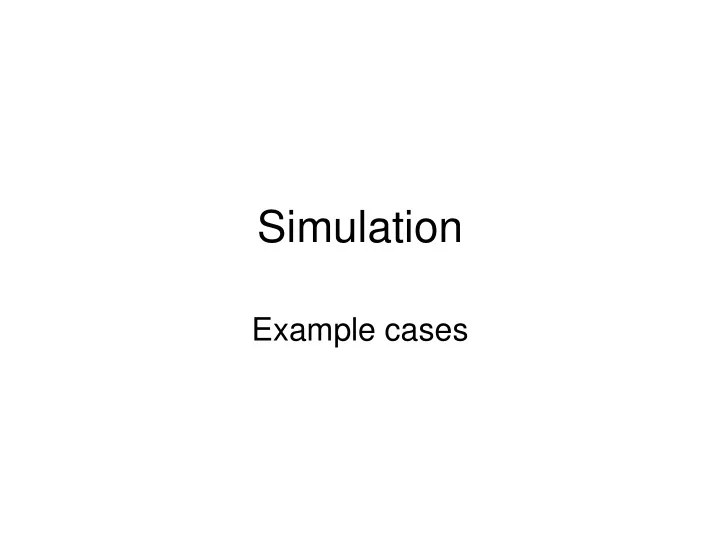

Simulation Example cases
Examples • Following cases will be discussed within the course (to varying degree of detail) – A car wash station – A logistic/delivery network – Surgery unit
Car wash (1/8) • System consists of – Stream of potential clients – Queuing place of limited capacity – Car wash machine • Goal – Compare the profit for two machines with different capacity
Car wash (2/8) • Profit/time unit • P= aU – b • b = fixed cost/time unit • a = profit/time unit during active utilization • U = utilization rate – a and b are known or can be estimated – U is to be simulated
Car wash (3/8) • We know • Behavior of potential clients (distribution of arrival times) • Maximal allowable length of the queue • Distribution of the service times • We want – Utilization rate U =T_busy/T_total • Or 1 – T_idle/T_total – Or the difference of rates for different models
Car wash (4/8) • One variable can describe the state – N(t)= number of clients at time t • Two types of events effect the state • Arrival: new client (i) arrives at time t= t_a(i) • Departure: client (j) leaves at time t= t_d(j) • If N=0, system is empty (machine not used). = > Simulation has to provide times when N=0 (or N>0).
Car wash (5/8) • If N(0), t_a:s and t_d:s are known, N(t) is uniquely determined and computable. – Simulation is needed to determine the arrival and (in particular) departure times. – Four variables + some counters • AT, DT (next arrival/departure time) • N (number of clients in the system) • t (current time) • E, T_idle (counters for collecting the idle time)
Car wash (6/8) • Set the duration of simulation (T), maximal queue length M. Initialize time t=0, counters (T0=0, E=0), Set N=0 (empty system), DT=maxint • AT= t+ ” arrival time ” • Repeat until t>T • If AT<DT play event”AT”, else play event ”DT” • Report the results
Car wash (7/8) • ”AT” • ”DT” – t=AT; – t=DT; – If N<= M, N=N+1; – N=N-1; – If N=1 – If N>0 • DT=t + ” service time ” • DT=t + ” service time ” • T0=T0+t-E; – Else – AT=t+”arrival time ”; • DT=maxint; • E=t;
Car wash (8/8) • ” Brute force ” approach for a simple case. • Hard to generalize to more complex situations • More event types, more complex state, need to follow the clients • ” Everything ” is selfmade • Date collection, book keeping of events and system state etc.
More complex examples • Examples with several components and their interactions – Supply/delivery chain with loading/unloading operations and transport delays – Chain of critical services that may block the flow in upstream direction – Hierachical services
Harbour network • Consider traffic in a network of several harbours • Assume average traffic between the harbours as known and given • Harbours have different properties (number and capacity of loading docks) • Boats have various fixed routes
Container harbour • What can be simulated/varied – Utilization rates, waiting times – Needed number of ships, durations of routes (average and variability) (impact on crew scheduling) – Effects of different routing strategies – Effects of different queuing strategies – Etc
Container harbour • Structural components of the model – Harbours – Docks – Ships – Containers? – Anything else? • Which components have to be identified
Container harbour • Events and interactions – Ship S arrives to harbour H – Loading/unloading of S begins at dock D – Loading/unloading of S ends at D – Ship S leaves for next harbour H(S) – (Ship S is created to the system) – (Ship S exits the system)
Container harbour • Simplified situation (ship arrives to a dock and is unloaded) • Most simple client-service – model – Create a ship and put it to a queue – Take a ship from a queue to the dock and start the loading (of known number of containers) – Unloading ends, dock becomes free, ship is removed
Container harbour • Big harbour has several docks • No point of managing similar docks individually • Create a pool of empty docks – In the beginning all dock in empty-pool – On ship’s arrival pick a dock from the pool – Reinsert the dock to the pool on ship departure
Container harbour • Ships have routes. – Create a ship, associate a route and place ship to starting position and state (loaded/empty/etc) – Ship starts journey to next harbour – Ship arrives, gets unloaded and moves forward – At the end ot the route the ship exits (or starts the next round)
Surgery unit • Typical surgery involves three stages – (supervised) preparation of the patient (aenesthetics etc) – Actual operation – (supervised) recovery • For each stage separate facilities are needed – How to plan the capacity for each stage
Surgery unit • Main modelling challenge is the capacity bottlenecks – If the next stage is fully booked the patient can not move forward – Operation room can not be freed without capacity in the recovery – Correct modelling is needed
Recommend
More recommend